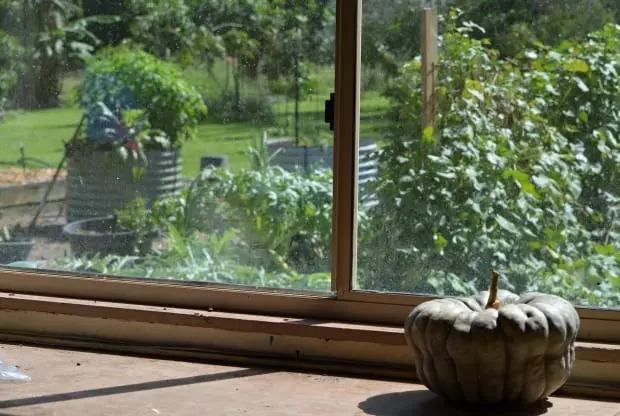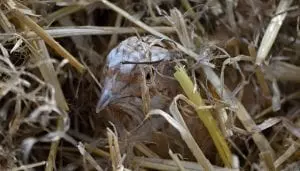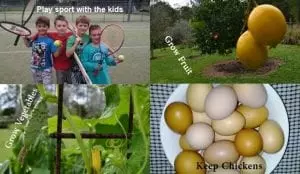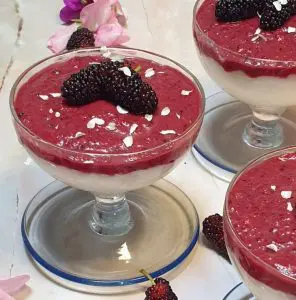Humans… we're funny creatures. We love new stuff and then we also love what's old. One of my favourite songs (by a German band) has the chorus: Destroy, improve, and re-build. For some reason, I love the freedom in the intent of the song and the premise conserving holds back creation.
But then, another part of me feels the complete opposite and I begin to romance over the history of certain “things” wondering how and why it was done, made, or built. Sometimes not everything that's modern is better and sometimes not everything old is worth conserving.

A Queensland Blue pumpkin curing by shed window (above image)
And, it's a bit like that for the world of growing vegetables with some new, “improved,” modern varieties (of old favourites) really worth trying and many others not worth the effort. Same–same, there are many good, old, “antique” vegetable varieties and some others that just aren't worth preserving – in my opinion anyway.
The origins of heirloom vegetables
For several thousand years (or more) humans have been cultivating and growing their own vegetables. As most of us know, the sheer fact humans evolved into settlers and farmers from nomadic tribes was an important turning point in the history of the human race. Having the stability of being settled in one place through sustainable food practices enabled humanity to breed, flourish, and invent instead of always moving to find or chase their next feed for survival.
I'd imagine in those early days of farming, vegetable varieties would have been limited with tribes, families, and groups exploring and searching for different produce to grow. There would have had to have been plenty of failures as people experimented with varieties of vegetables; however, the first person to cross breed plants (probably by accident) to produce an improved or different variety must have been amazed and extremely pleased with themselves.
Those types of discoveries would have lead to the beginnings of heirloom vegetables as we know them today, where special seeds of vegetables were handed down and kept within tribes or families to be grown over and over through generations. Heirloom – meaning something special and valuable to be inherited or handed down through generation, is where the term heirloom vegetables was born.

In those times, vegetable growing and seed keeping must have been extremely important and I'd imagine a packet of seeds with the potential to feed a family (and in some cases probably aid survival) would have been as worthy a hand-down as any material wealth is today.
Heirloom vegetables today
Nevertheless, today, heirloom seeds have a different value but they still are very important to many of us. Apart from the romance of growing a living antique (something from seed with origins hundreds or possibly thousands of years old) heirloom seeds have survived for one main reason – they're worth growing to eat.

Purple heirloom carrots going to seed with corn as a backdrop (image above)
Ironically, many heirloom varieties of vegetables have such an imbalance of great taste over mass production that they are not grown by large producers, and therefore, not commonly stocked on supermarket shelves simply because these varieties are too hard to commercially grow, harvest, or transport long distances.
That's why the world of heirloom vegetables is almost a secret underground network these days with backyard vegetable growers keeping these rare breeds alive through the love of gardening and an understanding of fresh, healthy, chemical free, produce.
However, just because the term “heirloom vegetables” is not mainstream and the produce not popular on supermarket shelves, doesn't mean it isn't a thriving business. Millions of food gardener nutters (like myself) are crazy about heirloom produce and there are very go od reasons why – here's some:
od reasons why – here's some:
- Propagation – Heirloom plants can be reproduced at home and seeds shared, swapped, or sold between individuals. It's not only cheaper to propagate your own plants but it's also a very satisfying hobby.
- Taste – Most heirloom vegetables taste unbelievably good; and, I say unbelievably literally because there are people who have only eaten supermarket vegetables all their lives! They couldn't possibly know or believe vegetables could have such flavour because, quite frankly, some supermarket veggies are bred to look good, and transport without bruising or spoiling, but taste is way down the list of priorities. By the way, taste is vitally important to ensure young children develop an interest in healthy eating.
- Variations – The variety of heirloom vegetables is humongous! Not just between different species but within a genus the variations differ as much visually as they do on the palate.
- Conservation and hobby – People like to grow and collect heirloom plants and this helps keep these (often ancient) vegetables from becoming extinct.
- Wow factor – Who doesn't like
 to surprise and wow friends and family? I'll never forget when my brother first saw my multicoloured cherry tomatoes growing in the garden, he looked at these white, black, and yellow, fruits and said, “there's something not quite right about a tomato not being red.” However, after tasting my tricolour Tommies he was converted… I think.
to surprise and wow friends and family? I'll never forget when my brother first saw my multicoloured cherry tomatoes growing in the garden, he looked at these white, black, and yellow, fruits and said, “there's something not quite right about a tomato not being red.” However, after tasting my tricolour Tommies he was converted… I think.
- Grow better – It isn't really true that heirloom vegetables grow better than modified or hybrid plants; actually, many of the later are specifically made to withstand pests and disease. However, there's no doubt heirloom vegetables bred and adapted to certain regions can out perform other plants. One huge advantage most heirloom plants do have over commercially adapted crops is the cropping. Commercial crops are designed for mass harvest with plants cropping and maturing all at once, but this can be a disadvantage for home grown produce causing an unwanted glut. Thankfully, many heirloom plants crop and mature over a longer period or slightly different times and thus gives us home food gardeners a chance to "pick as we need" for the kitchen.
Hybrid and genetically modified
You have to look pretty hard to find if a seedling or seed packet is true to type or actually some laboratory creation or hybrid. Producers of lab (genetically modified) or hybrid seeds and seedlings want us to buy their products but are inherently coy about letting us know these plants can't be replicated through seed saving at home. 
Honest producers and sellers will label F1 hybrid or “improved” on their products but many others will conveniently omit this important information or print it so small only children with 20/20 vision can read it. That's because, they know many avid home vegetable growers won't buy genetically modified, hybrid, or improved products if they can't save the seed and replicate the plant. It's sheer economics, because producers of modern improved vegetables want people to continuously return to purchase their products time and again. I'm not overly adverse to hybrid plants and seeds, to be honest, but I do prefer heirloom. As far as genetically modified vegetables go, I'm certainly not convinced they are safe – I know it's a personal opinion and I'm no scientist; nevertheless, there's something not right about altering genes that makes me feel uneasy about GM seeds.
True-to-type
Heirloom plants and seeds on the other hand, were cross-bred and stabilised naturally to ensure the variety grows “true-to-type” time and time again through seed saving.
Do true-to-type plants/seeds need to be “old” to adopt the name heirloom or can modern true-to-type varieties be classed as heirloom? There are those who believe true heirloom varieties should be plants which have been around for several decades or even 50 years. Others, like me, think even modern plants having true-to-type qualities being developed in the future should be classed as heirloom because they are able to be handed down/across or whatever.

Lettuce and chilli heirloom heaven… (image above)
One important point I must mention in this article is the caveat that just because a seed is deemed heirloom it doesn't necessarily mean the seed it produces will be true-to-type. I mean, it's supposed to be true-to-type but certain plants are easier than others at cross pollinating – plants like brassicas (for example) are easily crossed with others. In fact, all vegetables have the potential to cross pollinate with similar varieties from the same genus so amateur gardeners need to be aware of this rule.
Regardless, if for some reason your seed isn't true or you simply run out of seed and forget to save some, which happens to me all the time, then help a small business owner by rewarding their hard work and purchase some of their carefully grown and saved heirloom vegetable seeds. Buying seeds is great value and an inexpensive way to cover a large vegetable garden; plus, growing from seed is generally easy – children do it.
There are some really special varieties of heirloom vegetables to grow and some of my favourites are:
- Mizuna (purple or green leaf) – Let this Asian salad go to seed just once in your garden and you'll forever have seedlings, which have self-sowed. Used sparingly to spruce-up a salad, I love this salad green heirloom vegetable for its ease to grow and taste.

- Mammoth Red Rock Cabbage – As the name suggests, given the right conditions this cabbage grows large and is red/purple in colour. It's a super vegetable and great pickled, raw, or cooked.
- Red Giant Mustard – Terrific for flavouring dishes, and the stalks can be pickled! Looks great in the garden too.
- Purple climbing bean and Snake bean – The two easiest beans to grow and the most interesting. Purple climbing beans add colour and antioxidants to cooking. Snake beans grow long delicious pods which can be cooked whole for an interesting plate-up or segmented for a side vegetable. Both look amazing in the garden, are extremely hardy, and readily self-seed for the lazy gardener.
- Banana and mini capsicum – I like these varieties of capsicums because in my climate the larger bell type varieties don't grow well; however, banana and mini capsicums are prolific bearers and don't take up much space. Also, they tend to have very long seasons and can be treated as a perennial given the right care.
- Fennel – Let's call it a vegetable/herb because the root or bulb can be cooked as a delicious vegetable and the foliage is awesome as a flavouring. I love making my fennel pickles and boiled whole potatoes tossed in butter and sprinkled with chopped fennel leaves is something you must try! Fennel is also long lived in the garden and seemingly always available.

- Rainbow silverbeet (chard) – I live in a hot climate where most salad varieties tend to suffer tremendously under our summer heat and humidity, except for rainbow silverbeet. Its hardiness under all conditions perplexes me but I'm thankful because when all the lettuces have bolted and the spinach wilted, our silverbeet is always there to add as an emergency salad or ingredient to stir-fry. This magic heirloom vegetable has such longevity and after several months its large root juts out of the soil like a jagged island in the Galapagos.
- Pumpkin – There are heaps of weird and wonderful heirloom pumpkin varieties to try. For me, the standard butternut, and Jap/Kent are reliable plants. However, if you're looking for some unique vegetables it's hard to go past heirloom pumpkins with all sorts of shapes, sizes, colours, and textures on offer.
- Cucumber – Giant Russian, West Indian Gherkin, Suyo long, are just some of my favs. Pickled cucumbers are still the most popular preserve in my family.
- Chilli – Jalapeno, cayenne, Thai (small and medium). I am always looking for new chilli varieties because they are so good to eat and an extremely healthy power food. You rarely see a cooking show where chilli isn't used in some way to add flavour and spice. But, you don't have to grow hot chillies as the mild varieties are great for flavour too and can be used as a substitute for capsicum.
- Lettuce – Growing lettuce for its heirloom purposes is especially rewarding as not only is it reliably true-to-type but it also produces thousands of seeds and in the process of flowering attracts beneficial insects to the garden. Lettuce is one of those vegetables which germinates easily, grows fast, and requires little garden space.
- Tomato – The most popular heirloom plant in the world and for good reason. There's thousands of heirloom tomato varieties;
 unfortunately, you're unlikely to see them in a general store because most are just too hard to manage commercially. However, home grown heirloom tomatoes are exciting to grow. Discovering the different varieties for yourself and tasting the sheer pleasure of home-grown tomatoes is beyond words and is why fanatics like myself and millions of people worldwide have been obsessed with growing tomatoes for centuries. Red/black/yellow cherry, yellow pear, Italian tree, oxheart, mortgage lifter, black Russian, tigerella, Roma, Tropic, are some of my recommendations but I'm still yet to try so many myself.
unfortunately, you're unlikely to see them in a general store because most are just too hard to manage commercially. However, home grown heirloom tomatoes are exciting to grow. Discovering the different varieties for yourself and tasting the sheer pleasure of home-grown tomatoes is beyond words and is why fanatics like myself and millions of people worldwide have been obsessed with growing tomatoes for centuries. Red/black/yellow cherry, yellow pear, Italian tree, oxheart, mortgage lifter, black Russian, tigerella, Roma, Tropic, are some of my recommendations but I'm still yet to try so many myself.
Where can you get heirloom seeds and plants?
You can aquire heirloom seeds from a vast array of sources like: seed swapper clubs, gardening clubs, online communities (like our forum), friends, neighbours, and even via produce purchased from villiage markets.

Mini capsicum heirloom variety – I purchased these plants as a seedling (image above)
There are lots of good commercial heirloom seed providers (particularly online sellers in the USA, UK, and Australia). In the past I've used several good Australian and American heirloom seed producers both online and via traditional nurseries or retail. Personally, I like to routinely support online and shop-front heirloom seed and plant suppliers (rather than always propagate or aquire my own for free) because these businesses are providing a great service in collating many rare species of vegetables for us all to enjoy and discover.
Buying seeds and plants online is a great way to find rare and other plants you haven't yet tried. However, be sure to use trusted sites with reputation and ensure your local custom authorities will accept incoming seeds before committing to buy. Below is a short list of some heirloom stockists I support:
Beautanicals – http://www.beautanicals.com.au (also ships internationally)
Diggers – http://www.diggers.com.au (well organised online shop with huge selection of plants and seeds, also supplies heirloom seedlings to retail outlets)
Green Harvest – http://greenharvest.com.au (does also sell F1 Hybrid seeds but any hybrid seeds for sale are clearly labelled – a very good, and reliable family business)
Tomato Fest – TomatoFest (I love surfing this site as their tomato collection is fantastic!)
eBay – I've purchased lots of seeds from eBay in the past from quirky seed sellers and you never know what special or rare seeds you'll find.
Conclusion
Heirloom vegetables, what sayeth you! Go forth and grow thou crop of ancient fodder and you shall triumph in your own garden of Eden… Inspired yet? Seriously, there is a world of discovery out there in heirloom vegetable land and it's certainly much larger than what is portrayed on the supermarket shelves today. We owe it to our neanderthal ancestors to keep this tradition going not for our survival but for the survival of these wonderful vegetables and the great food they give us in return.
So go ahead and try some heirloom plants in your garden and save the seeds to regrow. Who knows, you might even surprise yourself and create your own variety or cross-breed to proudly name and hand down to the next generation of heirloom vegetable lovers.
Do you have an opinion? Then make a comment below or join our forum – Self Sufficient Culture.
I've also made a short video on heirloom vegetables – it's a little boring/slow but check it out if you want.
Thanks for reading and thanks for your support – it keeps me writing…
Mark Valencia – Editor SSM
Look, and see the Earth through her eyes…




 unfortunately, you're unlikely to see them in a general store because most are just too hard to manage commercially. However, home grown heirloom tomatoes are exciting to grow. Discovering the different varieties for yourself and tasting the sheer pleasure of home-grown tomatoes is beyond words and is why fanatics like myself and millions of people worldwide have been obsessed with growing tomatoes for centuries. Red/black/yellow cherry, yellow pear, Italian tree, oxheart, mortgage lifter, black Russian, tigerella, Roma, Tropic, are some of my recommendations but I'm still yet to try so many myself.
unfortunately, you're unlikely to see them in a general store because most are just too hard to manage commercially. However, home grown heirloom tomatoes are exciting to grow. Discovering the different varieties for yourself and tasting the sheer pleasure of home-grown tomatoes is beyond words and is why fanatics like myself and millions of people worldwide have been obsessed with growing tomatoes for centuries. Red/black/yellow cherry, yellow pear, Italian tree, oxheart, mortgage lifter, black Russian, tigerella, Roma, Tropic, are some of my recommendations but I'm still yet to try so many myself.











